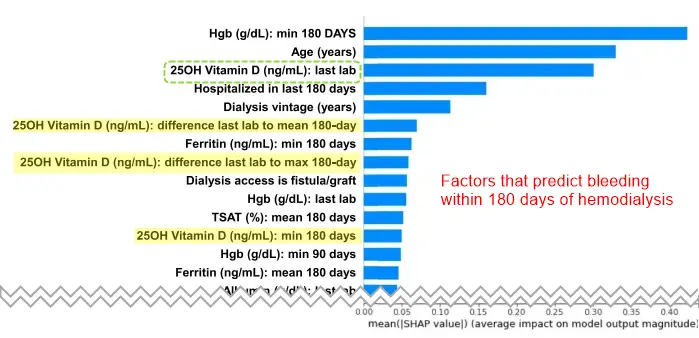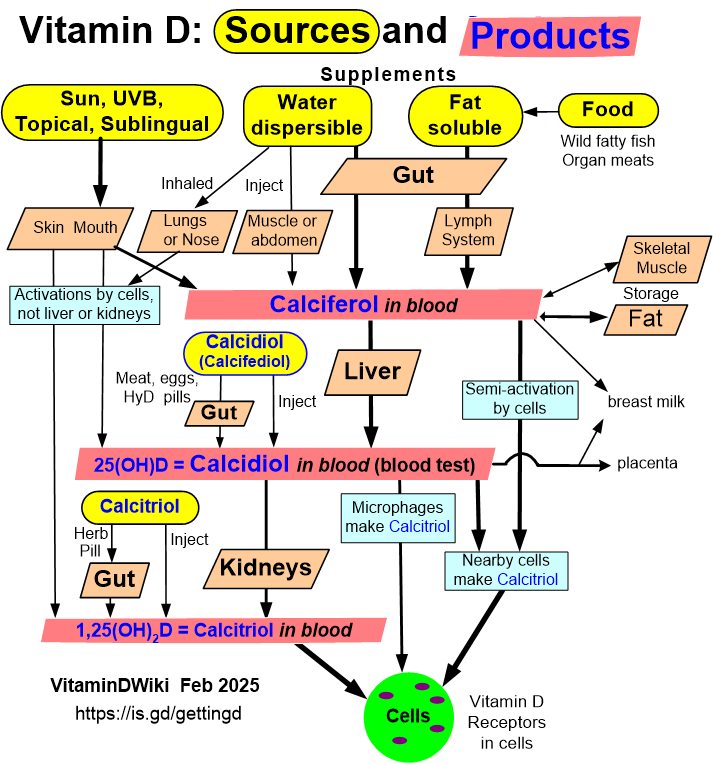Vitamin D is the 3rd best predictor of bleeding after hemodialysis
Prediction of gastrointestinal bleeding hospitalization risk in hemodialysis using machine learning
BMC Nephrology volume 25, Article number: 366 (2024)
John W. Larkin, Suman Lama, Sheetal Chaudhuri, Joanna Willetts, Anke C. Winter, Yue Jiao, Manuela Stauss-Grabo, Len A. Usvyat, Jeffrey L. Hymes, Franklin W. Maddux, David C. Wheeler, Peter Stenvinkel & Jürgen Floege on behalf of the INSPIRE Core Group

Background
Gastrointestinal bleeding (GIB) is a clinical challenge in kidney failure. INSPIRE group assessed if machine learning could determine a hemodialysis (HD) patient’s 180-day GIB hospitalization risk.
Methods
An eXtreme Gradient Boosting (XGBoost) and logistic regression model were developed using an HD dataset in United States (2017–2020). Patient data was randomly split (50% training, 30% validation, and 20% testing). HD treatments ≤ 180 days before GIB hospitalization were classified as positive observations; others were negative. Models considered 1,303 exposures/covariates. Performance was measured using unseen testing data.
Results
Incidence of 180-day GIB hospitalization was 1.18% in HD population (n = 451,579), and 1.12% in testing dataset (n = 38,853). XGBoost showed area under the receiver operating curve (AUROC) = 0.74 (95% confidence interval (CI) 0.72, 0.76) versus logistic regression showed AUROC = 0.68 (95% CI 0.66, 0.71). Sensitivity and specificity were 65.3% (60.9, 69.7) and 68.0% (67.6, 68.5) for XGBoost versus 68.9% (64.7, 73.0) and 57.0% (56.5, 57.5) for logistic regression, respectively. Associations in exposures were consistent for many factors. Both models showed GIB hospitalization risk was associated with older age, disturbances in anemia/iron indices, recent all-cause hospitalizations, and bone mineral metabolism markers.
XGBoost showed high importance on outcome prediction for serum 25 hydroxy (25OH) vitamin D levels , while logistic regression showed high importance for parathyroid hormone (PTH) levels.
Conclusions
Machine learning can be considered for early detection of GIB event risk in HD. XGBoost outperforms logistic regression, yet both appear suitable. External and prospective validation of these models is needed. Association between bone mineral metabolism markers and GIB events was unexpected and warrants investigation.
📄 Download the PDF from Vitamin D Life
Bleeding Incidence 2-6% – clipped from PDF
Major bleeding events have about a 2% to 6% incidence per year in dialysis [5–7], which is more than sevenfold higher than the incidence rate in the general population [8]. Bleeding events difer by modality, with higher rates seen in hemodialysis (HD) versus peritoneal dialysis (PD) [9]. Most bleeding events are due to a gastrointestinal bleed (GIB), with about 20% requiring hospitalization [5, 10]. Incidence of GIB hospitalizations has been increasing over time in the dialysis population [10]. Dialysis patients who experienced a GIB have a 90% higher risk of death occurring any time after the event, a risk that increases with every GIB event [10].
Vitamin D Life – Overview Kidney and vitamin D contains
{include}
Vitamin D Life – Chronic Kidney Disease needs Vitamin D - many studies
{include}
Vitamin D Life – Suspect that non-oral vitamin D is best for CKD
Sun, UVB, Topical, Sublingual forms get vitamin D to the cells, bypassing the kidneys
Doubt that CKD doctors or hemodialysis clinics are aware of this

Hemodialysis: 4 hours per session, 3 sessons per week, costs $80,000/year
40+ Vitamin D Life pages with HEMODIALYSIS etc in title
This list is automatically updated
{LIST()}
